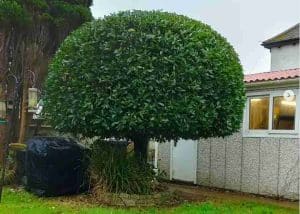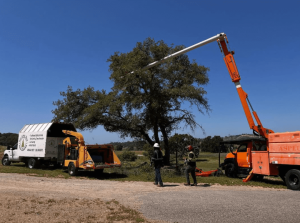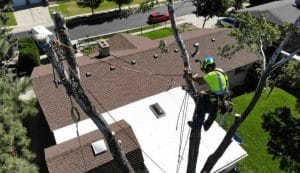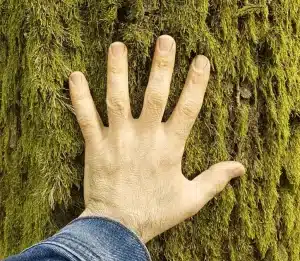Hidden tree damage is one of the most overlooked dangers after a hurricane in Florida. While fallen branches and toppled trees are easy to spot, cracks in the trunk, weakened roots, and broken limbs stuck in the canopy often go unnoticed and these issues can become hazardous days or even weeks later. One of the best ways to protect your home, family, and landscape is by learning how to identify these subtle signs of stress and damage early.
This article walks you through how to spot hidden tree damage step by step, with safety tips, and clear advice on whether to restore or remove a storm-hit tree. Whether you’re in Tampa, Miami, or Pensacola, the insights here can help you prevent costly repairs, reduce risks, and keep your trees healthy for the long haul.
Table of Contents
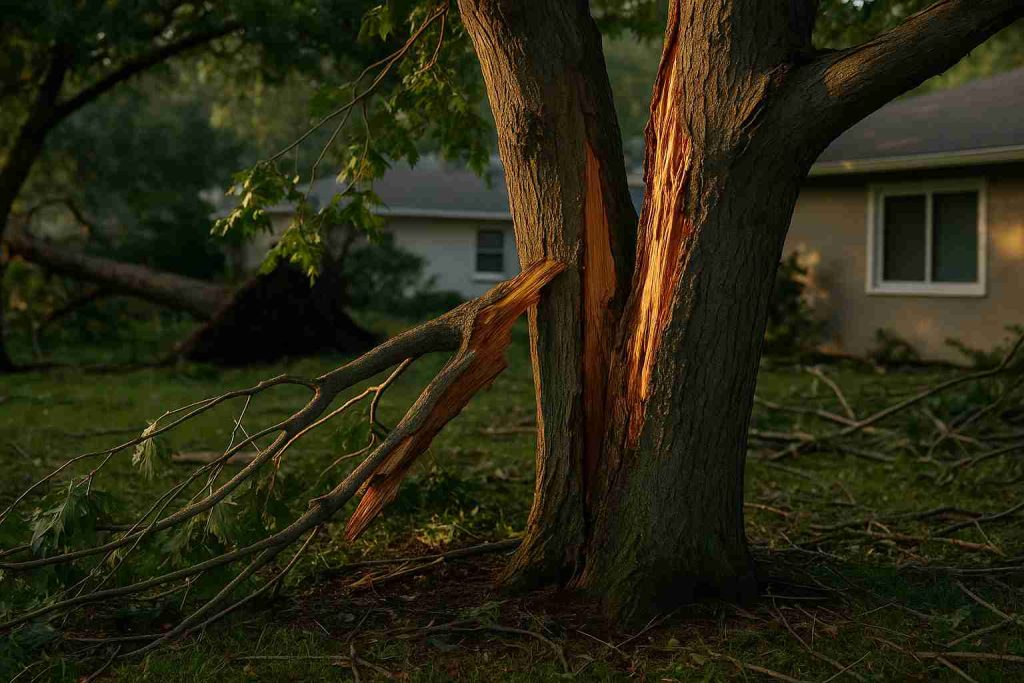
Why Hidden Tree Damage Matters?
Hurricanes bring intense winds, heavy rain, and flooding that can weaken even the strongest trees. These storms often strike during Florida’s hurricane season from June through November, putting trees under extreme stress. Gusty winds can twist trunks, snap branches, and loosen root systems. Saturated soil from heavy rainfall can drown roots or reduce their grip in the ground, making trees unstable.
While some damage like fallen limbs or uprooted trunks is easy to spot, many problems remain hidden. Cracked branches can hang in the canopy unnoticed, only to fall later and damage roofs, vehicles, or fences. A tree that looks healthy may be leaning due to weakened roots, posing a risk of falling during the next storm or even on a calm day.
Spotting this kind of hidden damage early can help you avoid costly repairs, prevent injuries, and protect your home. It also gives your trees a better chance of recovery. Healthy trees not only provide shade and beauty but also boost the safety and value of your property. By checking for signs of hidden damage after a hurricane, you make a smart investment in both safety and long-term care.
Step-by-Step Guide to Inspecting Trees After a Hurricane
Checking your trees after a hurricane doesn’t require fancy tools or expert knowledge. With a careful eye and a few simple steps, you can spot hidden damage and decide what to do next. Here’s how to inspect your trees safely and effectively:
1. Start with a Safe Survey
Before you get close to any tree, take a moment to look around. Check for downed power lines, loose branches, or leaning trees that could be dangerous. In places like Cape Coral or Palm Beach, where hurricanes often cause widespread debris, safety comes first. Walk around your property and note any trees that look different—maybe they’re leaning, have fewer leaves, or show broken limbs.
2. Look at the Trunk
The trunk is the tree’s backbone. Stand a few feet away and examine it from all sides. Look for cracks, splits, or areas where the bark is peeling off. These can be signs of internal damage, especially if the tree was twisted by strong winds. In Miami-Dade or Broward County, where hurricanes hit hard, even small cracks can weaken a tree over time.
3. Check the Roots
Roots anchor the tree in the ground, but hurricanes can loosen or break them. Look for lifted soil, exposed roots, or a depression on one side of the tree. If the ground feels soft or spongy near the base, the roots might be damaged. This is common in areas like Tallahassee, where heavy rain can saturate the soil and make trees unstable.
4. Inspect the Canopy
The canopy is the tree’s upper part, full of branches and leaves. Use binoculars if it’s hard to see high up. Look for broken branches that are still attached or stuck in other limbs. Brown or wilted leaves can also signal damage, though some trees lose leaves naturally after a storm. In Jacksonville, where storms like Hurricane Idalia cause widespread canopy damage, these signs are critical to catch early.
5. Test for Stability
If a tree looks like it’s leaning, gently push against it (if it’s safe to do so) to see if it feels loose. For smaller trees, you might notice the soil moving or the tree swaying too easily. This step is especially important in hurricane-prone spots like Fort Lauderdale, where leaning trees can pose a risk to homes and roads.
6. Monitor Over Time
Some damage, like internal cracks or root decay, doesn’t show up right away. Keep an eye on your trees for a few weeks after the storm. If you notice new leaning, falling branches, or dying leaves, the tree might be struggling.
By following these steps, you’ll get a clear picture of your trees’ health. If you spot anything worrying, don’t panic many trees can recover with the right care. The key is catching problems early to avoid bigger issues down the road.
Common Signs of Hidden Tree Damage to Watch For
Hurricanes can leave behind clues that your trees are hurt, even if they look okay at first. Knowing what to look for makes it easier to spot trouble. Here are the most common signs of hidden tree damage:
- Cracks or Splits in the Trunk: These can be small or deep and often happen when winds twist the tree. A cracked trunk weakens the tree and makes it more likely to fall.
- Leaning Trees: If a tree is leaning more than usual, its roots might be damaged. This is a big concern in places like Sarasota, where soggy soil can worsen the problem.
- Broken Branches in the Canopy: Branches that are cracked but still attached can fall without warning. These are sometimes called “widowmakers” because they’re so dangerous.
- Exposed or Lifted Roots: If you see roots sticking out of the ground or soil pushed up on one side, the tree might not be stable.
- Brown or Wilted Leaves: While some leaf loss is normal, large patches of dead leaves can mean the tree is stressed or damaged.
- Peeling Bark: Bark that’s pulling away from the trunk can signal internal decay or storm damage, especially in species like pines or oaks.
These signs can show up in any tree, from palms in Key West to live oaks in Ocala. If you notice any of them, take action to assess the tree’s safety and health.
Deciding Between Restoration and Removal
Once you’ve spotted hidden damage, the next step is deciding what to do. Can the tree be saved, or is it better to remove it? This choice depends on the damage, the tree’s health, and its value to your property. Here’s how to make the decision:
When to Restore a Tree
Many trees can recover from hurricane damage with proper care. Restoration is often possible if:
- The tree has most of its major limbs, trunk, and roots intact.
- There are no deep cracks, decayed wood, or exposed roots.
- The tree is a strong species, like a live oak or sabal palm.
- The tree is young or has a trunk less than 10 inches in diameter, making it easier to stabilize.
For example, a small tree in Pensacola that’s leaning slightly might be staked and pruned to recover. Watering the tree and flushing out salt from flooded soil (common in coastal areas like Naples) can also help. Be patient—trees may take months to grow new leaves or show signs of recovery.
When to Remove a Tree
Sometimes, removal is the safer choice. Consider removing a tree if:
- It’s leaning heavily with lifted soil or exposed roots, signaling major root damage.
- The trunk has deep cracks or splits that weaken its structure.
- More than half the canopy is gone, or the tree is missing large limbs.
- The tree is a weaker species, like a laurel oak, which struggles to recover from storm damage.
In places like Daytona Beach, where hurricanes can cause severe damage, removing a heavily damaged tree prevents it from falling on your home or neighbor’s property. Removal also reduces the risk of pests, like bark-boring beetles, which can attack weakened trees in Florida.
Getting Professional Help
If you’re unsure whether to restore or remove, a certified arborist can assess the tree’s condition. They have the skills to spot hidden damage and recommend the best action. Look for an arborist certified by the International Society of Arboriculture (ISA) by visiting treesaregood.org. This is especially helpful in urban areas like Tampa or West Palm Beach, where trees are close to homes and power lines.
By weighing these factors, you’ll make a smart choice that keeps your property safe and your trees healthy.
Safety Precautions When Checking Trees
Inspecting trees after a hurricane can be risky. Fallen power lines, unstable trees, and hidden branches can cause injuries. Follow these safety tips to protect yourself:
- Avoid Downed Power Lines: Stay far away from any wires on the ground or tangled in trees. Call Florida Power & Light at 1-800-468-8243 to report them.
- Wear Protective Gear: Use gloves, sturdy shoes, and a hard hat if you’re handling debris or getting close to damaged trees.
- Don’t Climb Ladders Near Damaged Trees: Broken branches can fall unexpectedly, especially in windy conditions common after storms in Florida.
- Work in Pairs: Have someone nearby in case of an emergency, especially if you’re in a rural area like the Panhandle.
- Leave Big Jobs to Pros: If a tree is leaning on a structure or near utility lines, don’t touch it. Professionals have the tools and training to handle these situations safely.
These precautions are critical in hurricane-prone areas like Fort Myers or the Keys, where debris and power outages are common after storms.
Preventing Future Tree Damage
While you can’t stop hurricanes, you can make your trees stronger for the next storm. Taking steps now reduces the chance of hidden damage in the future. Here’s how to prepare:
- Prune Regularly: Trim dead or weak branches before hurricane season (June to November). This creates an open canopy that lets wind pass through, reducing stress on the tree.
- Choose Wind-Resistant Trees: Plant species like sand live oak, sabal palm, or crape myrtle, which hold up well in storms. These are great choices for yards in Orlando or Lakeland.
- Strengthen Roots: Add mulch around the base of trees (but not touching the trunk) to keep soil moist and protect roots. This helps trees stay anchored in places like St. Augustine, where flooding is common.
- Brace Young Trees: Stake or brace newly planted trees to help them develop strong roots. This is especially useful in suburban areas like Boca Raton.
- Check Tree Health: Healthy trees are less likely to suffer damage. Water them regularly and watch for signs of pests or disease, which can weaken trees before a storm hits.
By preparing your trees, you’ll reduce the risk of hidden damage and make cleanup easier after the next hurricane.
Final Thoughts: Keep Your Trees and Property Safe
After a hurricane, the mess left behind is often obvious but the real danger may be hidden within your trees. Cracked trunks, loosened roots, and trapped branches don’t always show immediate signs of failure, yet they can pose serious threats to your home and safety in the days or weeks that follow. That’s why taking time to inspect your trees carefully is so important.
This guide has shown you how to recognize the warning signs of hidden tree damage and make smart decisions about restoring or removing affected trees. These steps are simple, effective, and essential for anyone living in a storm-prone region.
Don’t wait for the next big storm to reveal a problem. Walk your yard, look for subtle signs of stress, and reach out to a professional if anything feels unsafe. With just a little proactive care, you can protect your property, reduce future risks, and keep your landscape strong and healthy all year long.

FAQs
How do I check my trees after a hurricane in Florida?
After a hurricane, walk around your yard and look for trees that are leaning, have broken branches, or show cracks in the trunk. Also, check if roots are sticking out of the ground. These signs can mean the tree is damaged and might fall later.
What are signs of hidden tree damage after a storm?
Hidden damage includes cracks in the trunk, branches that are broken but still hanging, roots that are lifted or exposed, and trees that are leaning more than before. Leaves turning brown or falling off can also be a sign.
Should I remove a leaning tree after a hurricane?
If a tree is leaning and the soil around it is raised or the roots are visible, it might be unsafe and should be removed. However, small trees that lean slightly can sometimes be saved with support. It’s best to have a professional look at it.
Can I save a tree with broken branches after a storm?
Yes, if the main trunk is intact and less than half the branches are broken, the tree can often be saved by pruning the damaged parts. Make clean cuts to help the tree heal.
When should I call a professional to inspect storm-damaged trees?
Call a professional if a tree is near power lines, leaning towards your house, has large broken branches, or if you’re unsure about its safety. They can assess the risk and advise on the best action.
How can I prevent tree damage in future hurricanes?
Regularly trim dead or weak branches, choose wind-resistant trees like live oaks or sabal palms, and ensure trees are healthy. Proper planting and care can make trees more resilient to storms.
Do I need a permit to remove a storm-damaged tree in Florida?
In Florida, you usually don’t need a permit to remove a tree that’s a danger to people or property. However, local rules can vary, so check with your city or county before removing a tree.
What is a ‘widowmaker’ in tree damage terms?
A ‘widowmaker’ is a broken branch that’s still hanging in the tree. These can fall without warning and are very dangerous. Always look up and remove them safely after a storm.
How long after a hurricane should I monitor my trees?
Keep an eye on your trees for several weeks after a storm. Some damage, like root problems or internal cracks, might not show up immediately. Watch for changes like leaning or dying branches.
Can flooding after a hurricane affect my trees?
Yes, flooding can damage tree roots by depriving them of oxygen. This can weaken the tree and make it more likely to fall. If your yard was flooded, monitor your trees closely for signs of stress.

